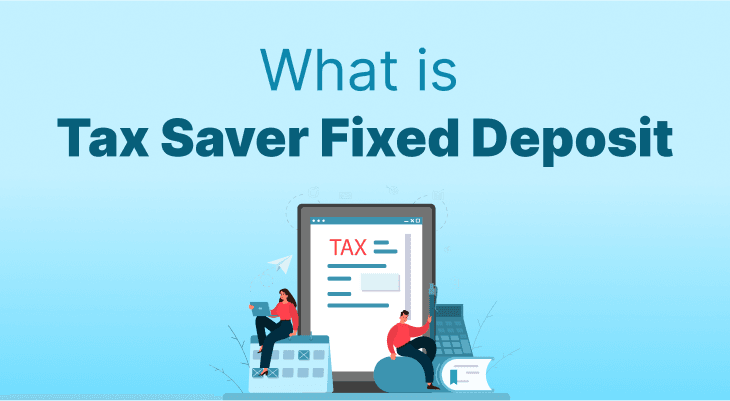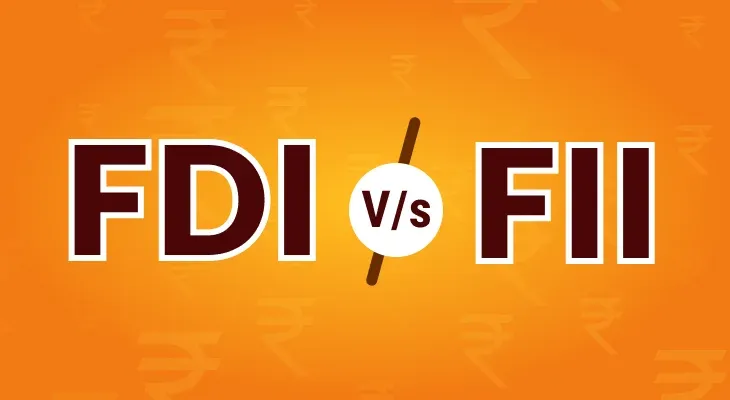
What is Tax Saver Fixed Deposit
Understanding what a tax saver fixed deposit is can help you save on taxes while generating consistent returns. Essentially, tax-saving FD is similar to regular fixed deposits, but with additional tax benefits. One notable characteristic is the 5-year lock-in term for tax saver FDs. This implies that funds cannot be withdrawn before the end of this term. These deposits, which are available through both public and commercial banks, often have interest rates ranging from 5.5% to 7.75%. If you wish to minimise your taxable income and safeguard your savings at the same time, you need to understand what a tax-saving FD is, how it works, its features, and its advantages.
How Does a Tax Saver FD Work?
Investing in a Tax Saver Fixed Deposit (FD) is a simple process that provides both tax savings and steady profits. Here's a full look at how it works:
Opening the FD:
Begin by choosing a bank that offers tax-saving FDs. Decide how much you wish to invest and complete the account opening process.
Lock-in Period:
The mandated 5-year lock-in term is a crucial component of tax-saver fixed deposits. During this time, the invested funds cannot be withdrawn.
Interest Rates:
These FDs provide competitive interest rates, which normally range between 5.5% and 7.75%. The rates may fluctuate depending on the bank's policy and the current market circumstances.
Tax Deduction:
The fundamental advantage of a tax-saving FD is its eligibility for a tax deduction under Section 80C of the Income Tax Act. Investors can deduct up to ₹ 1.5 lakh from their taxable income.
Maturity and Withdrawal:
At maturity, the principal amount plus the interest earned is credited to your account. It's worth noting that early withdrawal is not permitted during the lock-in period.
Taxation on Interest:
While the money invested is tax deductible, the interest generated on a tax-saving FD is taxable. TDS applies when interest reaches ₹40,000 in a fiscal year (₹50,000 for senior citizens).
Documentation:
To start a tax-saving FD, you must provide identification and address credentials such as a PAN card, Aadhaar card, passport, and utility bills.
Flexibility:
Some banks provide two types of interest payment options: cumulative (compounded and paid at maturity) and non-cumulative (paid at regular intervals).
Features of Tax Saving Fixed Deposits
Tax Benefits:
Investing in a tax-saving FD provides you a tax deduction of up to ₹1.5 lakh under Section 80C. This can drastically lower your taxable income and tax burden.
Lock-in Period:
These fixed deposits have a mandated 5-year lock-in term, guaranteeing that your assets are secure for a longer duration of time.
Interest Rates:
Interest rates on tax-saving FDs range from 5.5% to 7.75%. Banks frequently provide higher rates to senior citizens (between 0.25 to 0.5% higher), making it an appealing option for retirees looking for a stable income.
Nomination Facility:
You can name a beneficiary for your tax-saving FD. This option is not accessible if the FD is held on behalf of a minor.
Investment Limits:
The minimum investment amount is normally ₹1,000, with a maximum investment amount eligible for tax benefits under Section 80C of ₹1.5 lakh every financial year.
Interest Payout Options:
Investors can pick from cumulative and non-cumulative interest payment choices. In the cumulative option, interest is compounded and paid at maturity, but in the non-cumulative option, interest is paid out on a regular basis.
Safety and Security:
Tax-saving FDs are considered low-risk investments since they are unaffected by market movements. The returns are guaranteed, making them a safe choice for risk-averse investors.
Things to Consider While Investing in Tax Saving FD
Eligibility:
Resident individuals and Hindu Undivided Families (HUFs) can open tax-saving fixed deposits. Minors can also invest with an adult.
Premature Withdrawal and Loan Facility:
Premature withdrawals and loans against tax-saving FDs are not allowed. This assures that the money remains invested throughout the lock-in term.
Interest Rate Comparison:
Before investing, look at the interest rates offered by various financial institutions. A higher interest rate can significantly boost your profits over time.
Taxation on Interest:
The interest on tax-saving FDs is taxable. TDS is deducted on interest income above ₹40,000 in a fiscal year (₹50,000 for senior citizens).
Bank Selection:
Investments can be made through public or commercial banks, but not cooperative or rural banks. Post offices also provide 5-year fixed deposits that are eligible for tax deductions under Section 80C.
Safety Ratings:
Before investing, check the bank or financial institution's safety ratings. Ratings from agencies such as CIBIL and ICRA might assist you evaluate the risk.
Comparing Tax Saving FDs with Other Investment Options
| Type of Investment | Returns (in percentage) | Lock-in Period | Tax on Returns |
|---|---|---|---|
| Tax Saving FD | 5.5- 7.75 | 5 years | Yes |
| Public Provident Fund (PPF) | 7.1 (as of Jan 2024) | 15 years | No |
| National Savings Certificate (NSC) | 7.7 (as of Jan 2024) | 5 years | Yes |
| National Pension System (NPS) | 9% to 12% | Till Retirement | Partially Taxable |
The table above compares Tax Saving FDs to other popular tax-saving investment alternatives in India. Each investment option has varying returns, lock-in periods, and tax implications, allowing investors to make a decision depending on their financial objectives and risk tolerance.
Documents Required for Tax Saving Fixed Deposits
To open a tax-saving FD, you must supply identity and address verification. Accepted documents include:
Identity Proof
Passport
PAN Card
Senior citizen ID card
Voter ID card
Government ID card
Driver's licence
Address Proof
Passport
Bank statement with a cheque
Telephone bill
Certificate/ID card issued by the post office
Electricity bill
Points to Note While Submitting the Documents
Originals for Verification:
Prepare original documents for verification and submit photocopies.
Form Filling:
Fill forms in CAPITAL LETTERS using black ink (depending on bank discretion).
Countersign Overwriting:
Countersign if there are any overwritings.
Nomination Facility:
Utilise the nomination facility.
Permanent Address and Phone Number:
Provide a permanent address and phone number.
Conclusion
A Tax Saver Fixed Deposit is an excellent choice for investment for anyone looking for a secure, dependable, and tax-efficient method to build their funds. With a 5-year lock-in period and competitive interest rates, it provides the benefits of both tax savings and stable returns. Understanding the features, and benefits allows you to make an informed choice and improve your investment portfolio.
FAQ
How much tax deduction may be claimed on tax-saving FDs?
Investing in tax-saving FDs allows for a tax deduction of up to ₹1.5 lakh every financial year under Section 80C of the Income Tax Act. This deduction applies to the principal amount invested in these fixed deposits, which substantially lowers taxable income.
Is premature withdrawal allowed in tax-saving FDs?
No, premature withdrawals are not allowed from tax-saving FDs. These contributions are subject to a mandatory 5-year lock-in period during which the money cannot be retrieved.
What happens when a tax-saving FD matures?
At maturity, the invested money and accumulated interest are credited to the investor's bank account. It is crucial to note that the interest received on tax-saving FDs is taxed according to the investor's income tax bracket. TDS (Tax Deducted at Source) may apply if interest income exceeds ₹40,000 per year (₹50,000 for senior citizens).
Who should consider investing in a tax-saving FD?
Tax-saving FDs are ideal for investors who want to save tax while getting assured returns on their investments. These deposits are especially beneficial for risk-averse investors seeking stability and security because they are unaffected by market changes.
What is the lock-in period for tax saver FDs?
Tax saver FDs have a 5-year lock-in term, which ensures that the deposited money remains untouched for the stipulated length of time. This time is critical to qualify for tax benefits under Section 80C of the Income Tax Act.
Are there any specific eligibility criteria for investing in tax-saving FDs?
Individuals and Hindu Undivided Families (HUFs) can invest in tax-saving FDs. In addition, minors can invest with an adult guardian.
Can I get a loan against a tax-saving FD?
No, loans cannot be obtained against tax-saving FDs. The money must stay invested throughout the lock-in period, and early withdrawal is not permitted.
What are the interest payout options available for tax-saving FDs?
Investors have the choice between cumulative and non-cumulative interest payment choices.
What documents are required to open a tax-saving FD?
To start a tax-saving FD account, investors must provide both identity proof (such as a PAN card or passport) and address proof (such as utility bills or bank statements). These documents are required for verification purposes.
How does the interest earned on tax-saving FDs get taxed?
The interest generated on tax-saving FDs is taxed according to the investor's income tax bracket. To fully understand the tax implications, contact a tax advisor.


